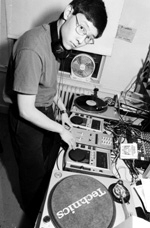Philip Tan, president and founder of the MIT Dance Mix Coalition (MITDMC), believes that MIT is the only university/college in the United States -- maybe in the world -- with an officially recognized DJ student group. A sophomore in literature, Mr. Tan formed the group last year to give MIT's student disc jockeys a central place to "mix," both socially and musically.
Mr. Tan and his colleagues are interested in mixing music at live events as opposed to radio-style DJing. In a recent series of IAP classes presented by the MITDMC, members of the MIT community received crash courses in techniques like "beatmatching" and "cueing." They also discovered what "trainspotting" is and what to do when "It's a party and no one's dancing!"
To celebrate its first anniversary, the MITDMC will host "SP@MIT: Slammin' Party! Synchronized Performers Step Precisely to Sonic Processing and Synthesized Percussion, with Stunning Playback of Sequential Pictures," on Friday, Feb. 19. Featuring performances and contributions by the Dance Troupe, the Anime Club and the Ballroom Dance Team, the evening is billed as a "one-of-a-kind nonstop multimedia phenomenon" and attendees are urged to "bring your dancing shoes." Doors open at 9pm in the Sala de Puerto Rico.
Mr. Tan credits the Association for Student Activities and Undergraduate Association Finboard with helping the group get this far, adding that SP@MIT is being financed by the UA/GSC Large Event Fund and the Council for the Arts at MIT.
Lynn Heinemann of the Office of the Arts asked Mr. Tan about the group.
Just what makes a good DJ?
Anybody who plays music on a CD player or turntable for someone else to hear is a DJ. A good DJ, on the other hand, must be sensitive to the audience, play music that they will appreciate, and arrange the music for maxiumum impact. Everything else is just a detail. SP@MIT places the DJ within sight of the audience -- they can see us and we can see them.
How did you begin "turntabling"?
I didn't -- I started with CDs, and I'm still a CD aficionado. A friend in my high school/pre-university in Singapore was into house music, club music, disco, etc. He had a pair of Technics SL1200MkII turntables and he showed me all the standard skills. I was very impressed by the fact you could blend disparate tracks into one song, almost seamlessly.
What inspired you to form this new club?
I found people at WMBR, MIT's radio station, who were into all sorts of dance music and music manipulation. At the same time, at rush events, I noticed that the student DJs were playing very mainstream radio music at dance parties, instead of more innovative club-style tracks. So we started the MITDMC to help expose the music we love.
I was also appalled that many students believed that alcohol was essential for a good party. People can have a good time and party without alcohol.
One way to have a good time is to dance to really good music. If the organizers of parties and the partygoers pay more attention to the music, alcohol can be a non-issue. The combination of music and adrenaline can be very effective.
Tell me about the SP@MIT event.
It's a multimedia party/performance to introduce good, non-mainstream club music to the MIT community. The music won't stop until 1am. The Ballroom Dance Team and Dance Troupe will do some exhibition dances, and the MIT Anime Club, an organization that views Japanese animation, will provide video visuals from their collection because the visual aspect of the club experience is also very important.
Isaac Murakami, a competitive turntablist who graduated from MIT in 1998, will present a showcase of turntablism, and Schwilly B from the Gnomefatty Collectiv, which organizes weekly performances at the Paradise Club near MIT, will also do a guest set.
What is competitive turntablism?
DJs have four to seven minutes to showcase scratching skills, showmanship and musical ability with turntables and a mixer in competitions that are known as 'battles.' The most creative DJ wins, although raw skill and speed helps. Turntablism is a very flexible and innovative art.
Will SP@MIT be rehearsed?
We may have a quick run-through with the dancers, but otherwise, no. The magic is in the spontaneity and on-the-fly manipulation of music based on the interaction between the DJs and the audience.
What kind of equipment will you use?
Turntables, CD players, mixers, amplifiers, speakers, effect lighting and video projectors. We're also trying to get permission to use fog machines and are working with the Campus Police.
A version of this article appeared in MIT Tech Talk on February 10, 1999.







